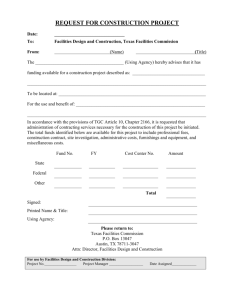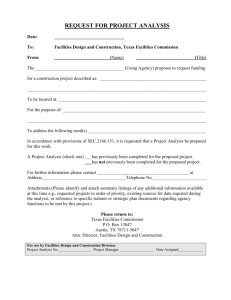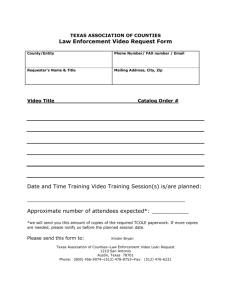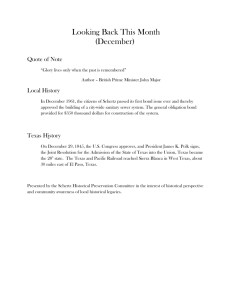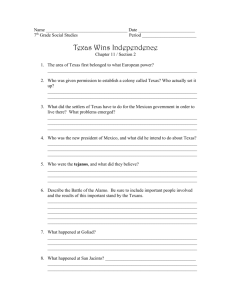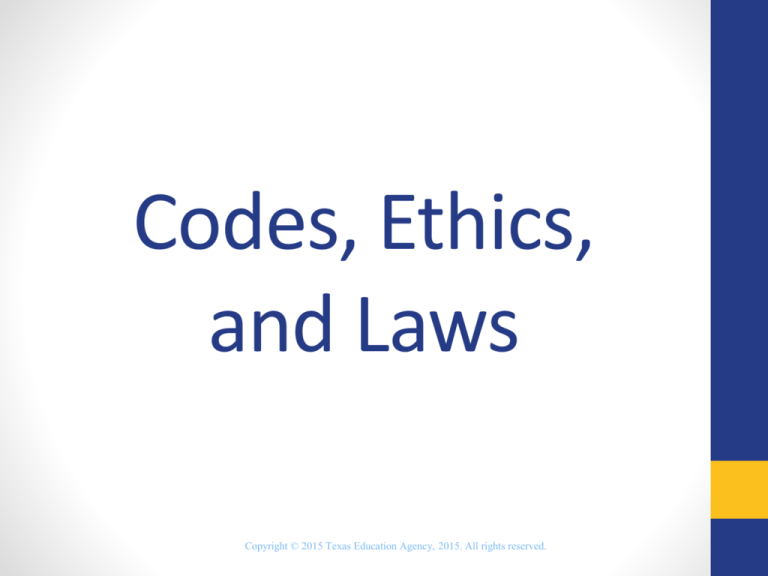
Codes, Ethics,
and Laws
Copyright © 2015 Texas Education Agency, 2015. All rights reserved.
Codes and Federal Regulations
• Interior designers are
legally responsible for
being aware of and
implementing applicable
local, state, or federal
codes.
• Federal regulations are
mandated by law and
required regardless of
local codes.
Copyright © 2015 Texas Education Agency, 2015. All rights reserved.
Codes
What are codes:
A collection of regulations, ordinances, and
other statutory requirements put together by
various organizations. Once adopted by
each jurisdiction, they become law. They
are enforced on a local level and sometimes
state level.
They provide for a minimum level of
performance, adequate standards of
practice, and uniformity of workmanship.
Copyright © 2015 Texas Education Agency, 2015. All rights reserved.
Purpose of Codes
Ensure public health and safety
throughout a building
Most have come into play “after-the-fact”
as a learning experience from a major
tragedy
They are primarily concerned with:
o
o
Construction requirements
Hazardous materials or equipment used in the
building
o 75% of all codes and standards deal with fire
o Energy conservation
o Accessibility
Copyright © 2015 Texas Education Agency, 2015. All rights reserved.
Four Types of Building Codes
Model Building Codes
Electrical Codes
Life Safety and Fire Codes
Residential Codes
Copyright © 2015 Texas Education Agency, 2015. All rights reserved.
Model Building Codes
Purpose: define construction
requirements and limit use of
hazardous materials
Copyright © 2015 Texas Education Agency, 2015. All rights reserved.
Common Codes
National Building Code (NBC)
Published by Building Officials Code Administration
(BOCA)
Standard Building Code (SBC)
Published by Southern Building Code Congress
International (SBCCI)
Uniform Building Code (UBC)
Published by the International Conference of
Building Officials (ICBO)
Copyright © 2015 Texas Education Agency, 2015. All rights reserved.
International Building Code
Published by the International Code Council
First established in 1994 and published in 2000
Most current edition is 2012 with a new edition
expected in 2015
Legacy codes are no longer being updated; IBC
is updated every three years
Some MS Jurisdictions adopted the code in 2003
This code has now replaced the three model
codes
Copyright © 2015 Texas Education Agency, 2015. All rights reserved.
It’s important to determine…
• At the start of every project, what codes and which
edition of the codes is being enforced in the
jurisdiction of your project
Copyright © 2015 Texas Education Agency, 2015. All rights reserved.
One and Two Family Dwellings
Code Requirements
Copyright © 2015 Texas Education Agency, 2015. All rights reserved.
Electrical Codes
Purpose: define construction
requirements for these specialties
Copyright © 2015 Texas Education Agency, 2015. All rights reserved.
Common Codes
National Electric Code (NEC)
Published by National Fire Protection Association
(NFPA)
Copyright © 2015 Texas Education Agency, 2015. All rights reserved.
Life Safety and Fire Codes
Purpose: establish minimum
requirements for fire safety
Copyright © 2015 Texas Education Agency, 2015. All rights reserved.
Common Codes – Fire Codes
ICC and NFPA now include fire codes
IFC International Fire Code
UFC Uniform Fire Code (NFPA 1 ®)
These address building conditions in
relation to hazardous conditions that
could cause a fire or explosion
Designers will address chapters on:
o Interior Finishes
o Furnishing and Decorative Materials
Copyright © 2015 Texas Education Agency, 2015. All rights reserved.
Common Codes – Life Safety Code
(LSF, or NFPA 101®)
One of the first codes published by NFPA
Revised every three years
2003, 2006, 2009, 2012 and 2015 versions
It is NOT a building code; it focuses on removal or
evacuation of all persons from a building by protecting
them from fire, smoke, and toxic fumes
Uses the Manual Style Format; first section
concentrates on broad topics, description of
occupancies, means of egress, and fire protection
Second part is divided into chapters by occupancy type
for new and existing buildings
Copyright © 2015 Texas Education Agency, 2015. All rights reserved.
Residential Codes
Purpose: define construction
requirements in one and two-family
dwellings
Copyright © 2015 Texas Education Agency, 2015. All rights reserved.
Common Codes
International Residential
Code (IRC)
•
First available in 1998
•
Based on the former One- and TwoFamily Dwelling Code
•
Applies to construction of single family,
duplex, and townhouses
Copyright © 2015 Texas Education Agency, 2015. All rights reserved.
Federal Regulations
• A number of federal agencies and departments work
with trade associations, private companies, and the
general public to develop federal laws for building
construction
Copyright © 2015 Texas Education Agency, 2015. All rights reserved.
Federal Regulations
These regulations are published in the Federal
Register (FR) and the Code of Federal Regulations
(CFR)
Published daily, but not all rules are enforceable laws
Once they have been passed into law, they are
published in the CFR annually
The federal government regulates its own buildings
Federal buildings have their own regulations and do
not use state or model codes (VA hospitals, military
bases, etc.)
They can pass federal legislation creating a law that
supersedes all other state and local codes and
standards; the ADA is an example
Copyright © 2015 Texas Education Agency, 2015. All rights reserved.
Americans with Disabilities
Act (ADA)
Developed by the
Department of
Justice
Four-part federal
legislation become
law on July 26th,
1990
Enforceable in 1992
and 1993
Copyright © 2015 Texas Education Agency, 2015. All rights reserved.
(ADA)
Is a comprehensive civil rights
law that protects individuals
with disabilities in the area of:
o
Employment (Title 1)
o
State and Local gov’t services and transportation
(Title II)
o
Public accommodations and commercial facilities
(Title III)
o
Telecommunications (Title IV)
Copyright © 2015 Texas Education Agency, 2015. All rights reserved.
Fair Housing Act
Federal legislation enforced by the Department of
Housing and Urban Development (HUD)
Protects the consumer from discrimination in
housing when buying or renting
Pertains to housing with four or more dwelling
units
As of 1991, these buildings must have accessible
public and common areas and ground floor units
must be accessible and meet specific construction
requirements
The FHA is often considered the residential
version of the ADA
Occupational Safety and
Health Act (OSHA)
Passed in 1970 to protect the American employee
in the work place
It regulates the design of buildings and interior
projects where people are employed
Employer must furnish a safe working
environment or can be fined
It also stresses the safe installation of materials
and equipment to ensure the safety of
construction workers
Copyright © 2015 Texas Education Agency, 2015. All rights reserved.
Ethics
• What are ethics?
• In the simplest terms, the word “ethics” A
number of federal agencies and departments
work with trade associations, private companies
and the general public to develop federal laws
for building construction.
• “Ethics” is something you either have or you
don’t have
Copyright © 2015 Texas Education Agency, 2015. All rights reserved.
Ethics is something that is learned
and chosen throughout one's life.
Copyright © 2015 Texas Education Agency, 2015. All rights reserved.
Common Workplace Ethics
Copyright © 2015 Texas Education Agency, 2015. All rights reserved.
Ethics
Punctuality
Responsibility
Copyright © 2015 Texas Education Agency, 2015. All rights reserved.
Ethics
Integrity and Loyalty
Teamwork
Copyright © 2015 Texas Education Agency, 2015. All rights reserved.
Ethics
Attitude
Professionalism
Copyright © 2015 Texas Education Agency, 2015. All rights reserved.


